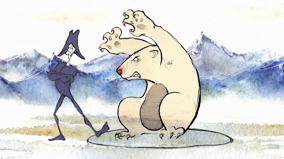The Living Stone
This documentary shows the inspiration behind Inuit sculpture. The Inuit approach to the work is to release the image the artist sees imprisoned in the rough stone. The film centres on an old legend about the carving of the image of a sea spirit to bring food to a hungry camp. Please note that this is an archival film that makes use of the word “Eskimo,” an outdated and offensive term. While the origin of the word is a matter of some contention, it is no longer used in Canada. The term was formally rejected by the Inuit Circumpolar Council …
to your list

This documentary shows the inspiration behind Inuit sculpture. The Inuit approach to the work is to release the image the artist sees imprisoned in the rough stone. The film centres on an old legend about the carving of the image of a sea spirit to bring food to a hungry camp.
Please note that this is an archival film that makes use of the word “Eskimo,” an outdated and offensive term. While the origin of the word is a matter of some contention, it is no longer used in Canada. The term was formally rejected by the Inuit Circumpolar Council in 1980 and has subsequently not been in use at the NFB for decades. This film is therefore a time-capsule of a bygone era, presented in its original version. The NFB apologizes for the offence caused.
-
directorJohn Feeney
-
scriptJohn Feeney
-
editingJohn Feeney
-
producerTom Daly
-
photographyPatrick CareyColin LowWally Gentleman
-
soundGeorge Croll
-
sound editingStuart Baker
-
narratorGeorge Whalley
-
musicMaurice Blackburn
Warning: Smoking and use of the word “Eskimo,” an outdated and offensive term.
This documentary features the process and conception of Inuit carving. This film can motivate deeper learning about the worldview of Inuit and their ways of knowing, being and doing. Students can research, discuss and create projects on the significant role of stories, beliefs and spirituality in art creation. Students can discuss how artists deeply connect with their medium, as well as the effort it takes to find stones that will be used to create works of art. Students can further explore the essential role that seals play in Inuit life.

















